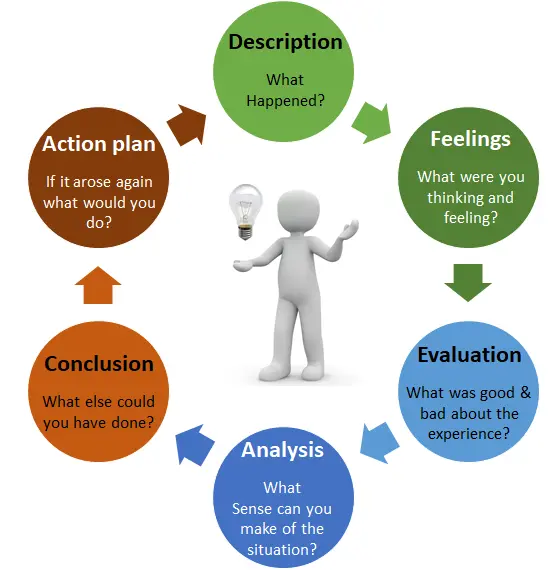+44 75754 30035 help@rapidassignmenthelp.co.uk
offer
🎁Special Offer 🎁 Discounts - Up to 55% OFF!
🎁Special Offer 🎁 Discounts - Up to 55% OFF!
Quadratus Lumborum strain is a musculoskeletal disorder associated with pain in the lower back region due to various reasons such as overuse, muscle imbalances, or poor posture. This Reflective Essay On The Case Study focuses on analyzing and discussing this condition using Gibbs’ Reflective Cycle. The essay covers six stages including description of the condition, feelings elaborating personal thoughts, evaluation, analysis of implementation, conclusion, and an action plan describing how the condition can be resolved in the future. This essay also elaborates on the crucial role of education and proper management related to this condition. It serves as valuable Assignment Help for students learning to apply reflective models in clinical case analysis, enhancing both understanding and academic performance..
The Gibbs Reflective Model is a widely used framework for structuring reflective writing, especially in healthcare education. This model involves six stages: Description, Feelings, Evaluation, Analysis, Conclusion, and Action Plan. It guides individuals through a detailed reflection on an experience, encouraging critical thinking and learning from practice. In this Reflective Essay On The Case Study, Gibbs’ model is applied to analyze the case of Quadratus Lumborum strain, helping to explore not only what happened but also the emotions involved, what worked well, and what could be improved. The model’s systematic approach aids in developing a clear action plan for future practice, making it an invaluable tool for students seeking Assignment Help to enhance their understanding and application of reflective practice in clinical settings.
A preliminary diagnosis of Quadratus Lumborum strain was made on the left side and this was as a result of overtraining coupled with a lack of warm-up or stretching exercises. The management’s plan included stretching exercises, manual therapies, and posture correction methodologies (Uslu, 2024). Explanation to the patient on mechanisms of stretching, importance, and regularity of warm-up incorporated into training, principles of training, and adequate rest was identified as one of the key components of the intervention. The patient is a year 13 student in school who plays plenty of sports and complained of dull lower back pain situated in the left QLs. Some of the lifestyle activities that the patient has include bike riding, going to the gym, swimming, and playing video games. The patient’s mother expressed worry over the possibility of postural problems especially having been informed that the patient has a family history of scoliosis. The pain was invented a couple of days before and attributed to an increase in gym workouts, it appears to be worse during twisting and flexion.

Figure 1: The Gibbs Reflective Cycle
(Source: https://www.researchgate.net/figure/Gibbs-reflective-cycle-Adapted-from-Gibbs-1988_fig1_371536633)
The patient stated the pain at 4/10 when it happens but the patient was completely asymptomatic during the consultation. It was a constant boring pain that did not spread or irradiate, it did not interfere with sleep but with daily activity. Tense muscles, more dominant in the higher zones for the left side, were hypertonic QL muscles, these findings reveal muscle stiffness and strain. Other previous injury history can be found for Parkour's falling accident which caused a left lateral hip contusion, but that was fine. This is the diagnosis: a strain of the left quadrature lumbourum originating from a workout and lack of warm-up exercises. Management plans which included stretching exercises, manual therapy, and positioning/postural modifications were put into implementation (Bhosale, and Burungale, 2022). Since stretching is vital in a patient’s training, it was recommended that the patient should be taught the right way of performing the exercises as well as the kind of warm-ups to perform most importantly, the right balance that has to be put in place between the kind and intensity of training and the time allocated to the same and rest.
Get assistance from our PROFESSIONAL ASSIGNMENT WRITERS to receive 100% assured AI-free and high-quality documents on time, ensuring an A+ grade in all subjects.
Thinking about the condition, I had some worries about the possible future repercussions of the pressure on the active, for the patient’s age, life position, and numerous related sports. This was magnified by the family history of scoliosis since an underlying problem with postural problems can complicate the common strain (Sundgren et al. 2021). However, knowing that QL strain is treatable under the right approach which includes therapeutic exercises, and manual therapy gave me some comfort. Explaining these strategies to the patient appeared relevant, as it prepares the patient for the process of rehabilitation and makes him/her more active. I also felt hopeful because the patient was compliant with the treatment plan and eager about the type of exercise as well as stretching procedures that they should learn to avoid.
Subsequent to assessing the situation, the diagnosis of Left Quadratus Lumborum strain was proper taking into consideration the signs, degree of activity, and history. Identifying the hypertonic QL muscles offered obvious manifestations of muscle tension owing to overwork. There were no features suggestive of radiating pain or clinically substantial functional limitation to warrant a different approach (Li et al. 2020). Some of the recommended activities were myofascial release, certain stretches, and a program for returning back to exercise with an emphasis on posture and biomechanics. However, this evaluation also stressed the need for education of the patient which is also an aspect of patient-centered care. It follows that when treating such a patient, one has to teach them how to stretch properly, modify their workout routines, and to identify the signs that indicate that strain is mounting. Evaluation also highlighted issues that needed to be addressed for instance explaining to the patient sort of stretching that is appropriate at any given point and the need to balance training with sufficient rest.
In order to outline an effective action plan, including broad protective measures into patient’s schedule is critical in regard to strain prevention in the future. The initial step of the plan involves introducing of a systematic stretching regimen aimed at enhancing the QL flexibility and the surrounding muscles. Such stretches as side bends, seated spinal twists, and hip flexor stretches will be used as targeted stretches to ensure the muscles feel relaxed and their flexibility is kept intact (SAMIR et al. 2024). To decrease spinal shear stresses and promote equal distribution of forces between the spine and the lower extremities, anterior core stability exercises including, planking, bird dog, and bridges will also be incorporated into the program. Strengthening of the core is more important since it helps in supporting the spine so that it does not get overloaded and at the same time it helps to reduce the workload on the QL muscle. Education is the key in this type of plan since the patients are the most important clients that need to benefit from this plan. It is therefore important for the learners to be trained on proper posture, especially with the aerobics activities as well as other day-to-day activities. Lack of standard posture and wrong mechanics in physical activity can negatively affect muscle tension, especially in the case of hereditary scoliosis. Posture and movement patterns should therefore be periodically assessed during follow-up sessions in order to establish whether there is any need to change the details of the management plan. With regard to scoliosis, concerns about the patient’s posture will be checked from time to time. There will be post-isometric relaxation activities like Wall Angels and Chin Tucks to ensure that the spine of the individual does not develop any tendencies related to scoliosis. Performance checks and constant audits will help in the quick identification of any trends that might go astray.
The gradual return to some form of physical exercise activity should be encouraged while keeping some guidelines in place as to how people should avoid getting injured. The patient will be asked to begin with light exercises and build up the intensity while at the same time ensuring proper technique (Ashoury, and Yalfani, 2024). It also important to stress such recovery measures as enough sleep, warm-up procedures, and correct movement patterns in order to avoid repetition. These strategies can be followed and by practicing, then the patient would continue with his/her fully active lifestyle without being prone to future injuries.
Conclusion
The application of reflection enhances my comprehension of specific clinical presentations, more specifically the Left Quadratus Lumborum strain in an active young person. This brought out the need for an assessment beyond symptom elimination to identify the contributing factors in the strain including muscle imbalance and poor training regimen. This study has effectively described the six stages in which it can represent the reflective analysis efficiently. Educating the patients about this condition is required to implement the proper strategies for how the patients can deal with the condition.
Action plan
The action plan for this scenario will be able to concentrate on the combination of preventive approaches for developing the schedule of the patient. This can involve the proper program in which it can focus to improve the flexibility in the case of QL with other muscles. It can integrate with the exercises related to core stability which can improve the support of the spine (Alver et al. 2022). The constant education on the significance of maintaining a suitable posture, particularly in a time of dynamic activities can be considered as critical. Based on the scenario of the scoliosis daily checking and assessments for posture maintenance can also be incorporated into the sessions. Sessions of daily follow-ups can be scheduled to observe the development and can also be adjusted to the management plan. So the patient is required to be motivated to resume physical activities which can be used as a guideline in the prevention of injury.
Conclusion
This study has concluded the reflective essay effectively with the help of the representation of Gibbs's reflective cycle. This study has represented the condition of the study in a reflective way. This reflective essay is able to describe all of the stages based on the condition of the patient and elaborate on how this condition can be improved. This has focused mainly on the condition of the student and how this condition can be resolved in a better way. The six stages of this model are represented in this study.
Reference List
Journals
Introduction: Impact of Climate Change on the Financial Industry: Risks and Challenges Academic and Professional Skills are...View and Download
Introduction: UHC's Role in Health Rights and SDG3 Promotion Need help with assignments on Universal Health Coverage and...View and Download
Introduction Struggling with assignments? Get professional Assignment Help for top-notch academic support. Our experts ensure...View and Download
Introduction Get expert guidance with Online Assignment Help! We offer plagiarism-free work, timely delivery, and support across...View and Download
P1 Assess own personality traits and attributes in terms of them having a positive or negative effect on management approaches...View and Download
Introduction Rapid Assignment Help transforms academic challenges into stepping stones with personalized Assignment Help for...View and Download
